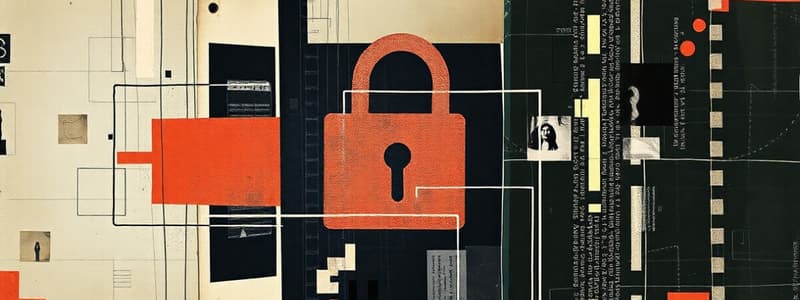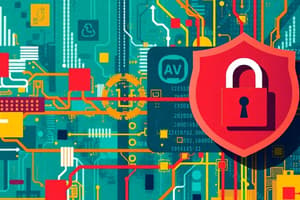Podcast
Questions and Answers
Which activity is considered a computer crime?
Which activity is considered a computer crime?
- Developing new software applications
- Illegally browsing a company's private information (correct)
- Performing routine system maintenance
- Implementing network security protocols
What is the primary function of a firewall in network security?
What is the primary function of a firewall in network security?
- To speed up internet connection speeds
- To encrypt all data transmitted over a network
- To provide wireless internet access to users
- To prevent unauthorized access to or from a private network (correct)
In the context of data security, what does encryption primarily ensure?
In the context of data security, what does encryption primarily ensure?
- Data is backed up automatically to prevent loss
- Data is quickly accessible to all users
- Data is compressed for efficient storage
- Data is converted into a format unreadable by unauthorized users (correct)
How do computer viruses, akin to biological viruses, operate?
How do computer viruses, akin to biological viruses, operate?
What is the purpose of regularly creating a backup of computer files or data?
What is the purpose of regularly creating a backup of computer files or data?
What role do 'cookies' play in web server operations?
What role do 'cookies' play in web server operations?
How does decryption relate to encrypted data?
How does decryption relate to encrypted data?
What is the key distinction between a Trojan and a virus?
What is the key distinction between a Trojan and a virus?
What condition typically triggers the payload in a 'Cascade' virus?
What condition typically triggers the payload in a 'Cascade' virus?
How does running a program infected with an 'Anti EXE' virus typically affect a computer system?
How does running a program infected with an 'Anti EXE' virus typically affect a computer system?
Flashcards
Data security
Data security
Protecting data from destructive forces and unwanted actions.
Hacker
Hacker
Gaining illegal access to information via computer.
Cookies
Cookies
Small files used by web servers to recognize returning visitors.
Encryption
Encryption
Signup and view all the flashcards
Decryption
Decryption
Signup and view all the flashcards
Computer crime
Computer crime
Signup and view all the flashcards
Backup
Backup
Signup and view all the flashcards
Firewall
Firewall
Signup and view all the flashcards
Gibberish
Gibberish
Signup and view all the flashcards
Decipher
Decipher
Signup and view all the flashcards
Study Notes
- Data security protects data like databases from destructive forces and unwanted actions.
- Computer criminals can infiltrate computer systems and steal confidential information.
- A hacker gains illegal access to information via computer.
- Viruses enter PCs via email attachments or when files are downloaded from the Internet.
- Cookies are small files web servers use to identify return visitors.
- Encryption encodes data to prevent unauthorized users from reading it.
- Decryption decodes encrypted data.
- A virus becomes active when an infected program is run, infecting other programs.
- Computer crime is an act performed by a knowledgeable computer user that illegally browses or steals private information.
- Computer crimes include phishing, malware, money laundering, software piracy, identity theft, and cyber stalking.
- Cyber stalking involves using the Internet to harass or stalk individuals or groups and may include false accusations.
- A backup is a copy of a file or data used to protect against accidental loss or corruption.
- A firewall prevents unauthorized network access.
- Computer viruses reproduce inside a host, which they damage or destroy, similarly to biological viruses.
- A virus patching the operating system can copy itself into any program files.
- Some viruses load into memory to stay dormant until triggered.
- Payload examples, particularly in the context of software and cybersecurity, encompass various actions such as sending a notification to a user or erasing specific files from a system. These functions can serve as alerts or as methods to carry out malicious tasks in an exploit scenario.
- Viruses often attach to COM or EXE programs.
- A Trojan has a payload but lacks a reproduction routine.
- "Anti EXE" viruses will corrupt, overwrite, and lose data via various methods.
- A logic bomb is activated when a dismissed employee's name is deleted, which results in the destruction of payroll records.
- Cascade viruses trigger a payload when a date occurs that makes characters on a text mode screen slide down to the bottom.
- A MIDI message encodes sound into code as 8-bit bytes of digital information.
Safe Data Transfer
- Privacy.
- The recipient's private key
- Public-key cryptography
- Decrypt
- Create MAC
- Information about the company operating the server and the server's public key.
- To encrypt a message for sending: The recipient public key
- To decrypt a received message: The recipient private key
- To encrypt the MAC of a message: The sender's private key
- To encrypt the MAC of a digital signature: Trusted issuer' private key
- Gibberish: meaningless data
- Imposter: Person pretending to be someone else
- Decipher: Convert to meaningful data
- MAC: Message-authentication code
- Tenets: Principal features
- Tamper: Make unauthorized changes
Some Definitions
- Incremental backups – Copies of changes to files made to reduce the risk of loss of data.
- Shareware – Software available for a short time on a free trial basis if adopted a fee is payable to the author.
- Cannot be disrupted or cut – Under lock and key
- Put at risk – Compromise
- Deciphered, worked out – Decoded
- Encrypt – Protect data by putting it in a form only authorized users can understand.
- Firewall – A combination of hardware and software to protect networks from unauthorized users.
- Audit – Observe and record systematically.
- Biometrics – Measuring physical characteristics such as distance between the eyes.
- Frequent intervals – Periodic audits
Studying That Suits You
Use AI to generate personalized quizzes and flashcards to suit your learning preferences.




